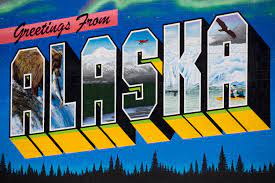By Laura Ditto
Part 2 in a series on APU’s involvement Indigenizing the G Street mural.
With the new mural coming to 645 G Street, I reached out to one of the project coordinators, Michael Fredericks, to hear her thoughts on the art piece. Over a phone call, she talked about how murals can shape community, how portrayals of identities can bring forth pride, and why public art is so integral to shaping a welcoming city.
Fredericks is of Yupik decent and employed with the SALT interior design company. She works in the office building where the mural will be installed and is part of the Roadmap to a Vital and Safe Anchorage (RVSA). RVSA has a goal to make the city more resilient, sustainable, safe, and vibrant as it reopens from the COVID-19 pandemic, according to their website. Part of RVSA’s plan to “activate Downtown” is not only to create a safe way to navigate the area, but to also make the city more beautiful by engaging artists in short- and long-term installations.
“If you look at any of the great places that we all like to visit, they have things like that. Like Chicago has The Bean… and, you know, Paris has the Eiffel Tower and all these weird things, right? Murals are becoming a much more attainable way of creating statements and art in cities,” Fredericks said.
“And they’re changeable, so as we evolve and become something, our art can evolve with us,” Fredericks added. “The new generations of people that have all this openness and new definitions for things can be creating things that make us think about what’s next for us.”
Because murals can be viewed by the public for years to come, it is important to think of the impact they can have on future generations. Fredericks described Crystal Worl’s design for the mural as one that celebrates the many identities of Anchorage, and how everyone in the city can coexist going forward.
“I imagine the first day I walk my ten-year-old son past that mural that Crystal has conceived of, that I can talk about all these amazing things that he is. ‘Cause he’s not one thing, you know? … He’s a person, and he’s complex, and he’s dynamic, and has so much potential, and none of those identifiers or labels should hold him back from anything,” Fredericks shared.
“Although this is a Dena’ina place, there are so many different kinds of people that are here and all that diversity creates, I think, real innovation,” Fredericks said. “I think the more diverse our thinking, our people, and our actions are, the better off we are. I think if we all thought alike, or if we all were from the same thing, it would be very boring.”
While speaking to Fredericks about the public input meeting that occurred in late February, she shared her thoughts on the discussion that was had about the duality between differing people in one space. Fredericks describes Worl’s ideas as not only highlighting the diverse city, but also creating plurality—the ability to be various identities at once.
“Anchorage is many things, and all those things can coexist as long as we stick to our bases… our humanity,” Fredericks explained. “We just have to remember it is not a cancel culture. It is the open your arms wide culture, and listen to it all, and respect it all. We don’t need to create division; we need to create plurality.”
Before the interview ended, Fredericks shared her excitement for the new mural. “It’s such an opportunity to continue to pull out what is unique and beautiful about where we’re at instead of being bombarded with what’s wrong… I’m just super honored to be a part of it and I also hope it becomes something we can do much more of.”
Click here to read Part 1 introducing the mural project.

